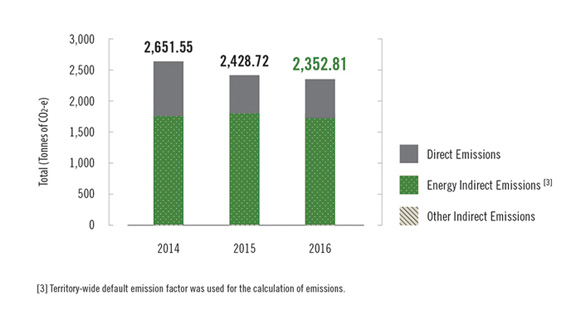Report Functions
Supporting Information
In-house Green Management
ArchSD is committed to infuse green elements to our own operations through proactive environmental management and staff engagement. On one hand we incorporate environmental considerations into our projects, on the other hand we also implement in-house green initiatives to manage our energy, waste, water and indoor environmental quality issues.
Energy Efficiency and Carbon Reduction
ArchSD has maintained an integrated management system certified to ISO 14001 Environmental Management System, ISO 9001 Quality Management System and OHSAS 18001 Occupational, Health and Safety Management System. In the year under review, we have engaged an external consultant to assist our upgrade of ISO 9001 and ISO 14001 systems. To strengthen our energy management, we also implemented an ISO 50001 certified Energy Management System (EnMS) for our APB Centre since 2014.
To recognise our achievement in energy conservation, we are granted "Class of Excellence" of Energywi$e Certificate in the Hong Kong Green Organisation Certification (HKGOC) scheme.
305-1
As part of government's effort to mitigate climate change, all existing government buildings are encouraged to carry out carbon audit regularly to monitor the effectiveness of carbon reduction measures. Since 2010, we have been conducting annual carbon audits and identify room for improvement for our offices in the QGO and APB centre. There are some experimental PV panels on the roof top of the APB Centre. The saving offsets slightly the electricity bill. There three major GHG contributors to the carbon footprints are CO2, CH4 and N2O. Therefore, the carbon footprints of QGO and APB Centre over the past three years are as follows:
Carbon Emissions in the Queensway Government Office
| FY2013-14 | FY2014-15 | FY2015-16 | |||
|---|---|---|---|---|---|
| Direct Emissions (Tonnes of CO2-e) | 14.90 | 18.92 | 6.90 | ||
| Energy Indirect Emissions (Tonnes of CO2-e) [1] | 2,277.59 | 2,344.73 | 2,255.11 | ||
| Other Indirect Emissions (Tonnes of CO2-e) [2] | 39.02 | 34.72 | 83.78 | ||
| Total (Tonnes of CO2-e) [2] | 2,331.51 | 2,398.37 | 2,345.79 | ||
| [1] | Territory-wide default emission factor was used for the calculation of emissions. |
|---|---|
| [2] | The figures in FY 2013-14, FY 2014-15 and FY 2015-16 are calculated by using the actual paper consumption (A4&A3) and waste paper collected for recycling. |
Carbon Emissions in APB Centre
| 2014 | 2015 | 2016 | |||
|---|---|---|---|---|---|
| Direct Emissions (Tonnes of CO2-e) | 886.29 | 619.08 | 628.22 | ||
| Energy Indirect Emissions (Tonnes of CO2-e) [3] | 1,756.58 | 1,802.93 | 1,719.53 | ||
| Other Indirect Emissions (Tonnes of CO2-e) | 8.68 | 6.72 | 5.05 | ||
| Total (Tonnes of CO2-e) | 2,651.55 | 2,428.72 | 2,352.81 | ||
| [3] | Territory-wide default emission factor was used for the calculation of emissions. |
|---|
Waste Management
In line with government’s initiatives in waste reduction, we have arranged collection facilities for a wide range of items including waste paper, aluminium cans, plastics bottles, used CDs or DVDs, used rechargeable cells, used printer toner cartridges in our office premises. We also worked proactively with our IT equipment suppliers to facilitate the reuse and recycling of computers in offices. During the year, we successfully recycled 16,060 kg of waste paper and attained the "Class of Excellence" Wastewi$e Certificate of HKGOC in recognition of our effort.
Water Consumption
As an on-going initiative, we monitor potable water and flushing water consumption at our offices on a regular basis. To sustain water resources, we have adopted a variety of water saving devices including sensor taps, dual flush cisterns and devices with water efficiency labels under Water Efficiency Labelling Scheme in APB Centre. With the aim to disseminate water saving measures to staff, we have developed and incorporated water saving tips and guidelines into the Department's General Circular "Measures of Green Housekeeping".
Indoor Environmental Quality
Good indoor air quality (IAQ) is fundamental to the maintenance of health. To ensure a healthy and safe environment for our staff, we strictly follow relevant guidelines published by the Environmental Protection Department to maintain good IAQ levels in our workplace. To regularly monitor and assess the IAQ, we also engage accredited bodies in conducting IAQ measurements on the parameters specified in EPD's guidelines. During the year, we are granted "Basic Level" of IAQwi$e Certificates for QGO and APB Centre.
Cultivating a Green Culture
Green management is effective in educating and encouraging our staff to adopt environmentally responsible behaviours. A team of Green Wardens (previously known as energy warden) with members from various branches and divisions has been appointed since 2006 to assist in implementing and monitoring the environmental programmes of ArchSD. Currently, we have around 96 nos. of Green Wardens in the team to safeguard our green measures.
To continuously enhance our staff awareness, we provide training for staff members to enhance their environmental awareness and knowledge in specific green aspects. Up to December 2016, 176 staff members of ArchSD have obtained the BEAM Pro qualification.
© Copyright 2017













